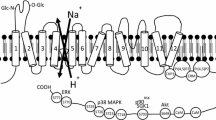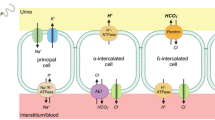Abstract
The Na+/H+ exchanger isoform 3 (NHE3) is essential for HCO −3 reabsorption in renal proximal tubules. The expression and function of NHE3 must adapt to acid–base conditions. The goal of this study was to elucidate the mechanisms responsible for higher proton secretion in proximal tubules during acidosis and to evaluate whether there are differences between metabolic and respiratory acidosis with regard to NHE3 modulation and, if so, to identify the relevant parameters that may trigger these distinct adaptive responses. We achieved metabolic acidosis by lowering HCO −3 concentration in the cell culture medium and respiratory acidosis by increasing CO2 tension in the incubator chamber. We found that cell-surface NHE3 expression was increased in response to both forms of acidosis. Mild (pH 7.21 ± 0.02) and severe (6.95 ± 0.07) metabolic acidosis increased mRNA levels, at least in part due to up-regulation of transcription, whilst mild (7.11 ± 0.03) and severe (6.86 ± 0.01) respiratory acidosis did not up-regulate NHE3 expression. Analyses of the Nhe3 promoter region suggested that the regulatory elements sensitive to metabolic acidosis are located between −466 and −153 bp, where two consensus binding sites for SP1, a transcription factor up-regulated in metabolic acidosis, were localised. We conclude that metabolic acidosis induces Nhe3 promoter activation, which results in higher mRNA and total protein level. At the plasma membrane surface, NHE3 expression was increased in metabolic and respiratory acidosis alike, suggesting that low pH is responsible for NHE3 displacement to the cell surface.







Similar content being viewed by others
References
Adam WR, Koretsky AP, Weiner MW (1986) 31P-NMR in vivo measurement of renal intracellular pH: effects of acidosis and K+ depletion in rats. Am J Physiol 251:904–910
Adrogue HJ, Madias NE (2010) Secondary responses to altered acid-base status: the rules of engagement. J Am Soc Nephrol 21:920–923
Ambuhl PM, Amemiya M, Danczkay M, Lotscher M, Kaissling B, Moe OW, Preisig PA, Alpern RJ (1996) Chronic metabolic acidosis increases NHE3 protein abundance in rat kidney. Am J Physiol 271:917–925
Amemiya M, Yamaji Y, Cano A, Moe OW, Alpern RJ (1995) Acid incubation increases NHE-3 mRNA abundance in OKP cells. Am J Physiol 269:126–133
Amin MR, Malakooti J, Sandoval R, Dudeja PK, Ramaswamy K (2006) IFN-gamma and TNF-alpha regulate human NHE3 gene expression by modulating the Sp family transcription factors in human intestinal epithelial cell line C2BBe1. Am J Physiol Cell Physiol 291:887–896
Bernardo AA, Bernardo CM, Espiritu DJ, Arruda JA (2006) The sodium bicarbonate cotransporter: structure, function, and regulation. Semin Nephrol 26:352–360
Bezerra CN, Girardi AC, Carraro-Lacroix LR, Reboucas NA (2008) Mechanisms underlying the long-term regulation of NHE3 by parathyroid hormone. Am J Physiol Renal Physiol 294:1232–1237
Biemesderfer D, DeGray B, Aronson PS (2001) Active (9.6 s) and inactive (21 s) oligomers of NHE3 in microdomains of the renal brush border. J Biol Chem 276:10161–10167
Bobulescu IA, Moe OW (2006) Na+/H+ exchangers in renal regulation of acid–base balance. Semin Nephrol 26:334–344
Boron WF (2006) Acid–base transport by the renal proximal tubule. J Am Soc Nephrol 17:2368–2382
Cano A (1996) Characterization of the rat NHE3 promoter. Am J Physiol 271:629–636
Charney AN, Egnor RW, Cassai N, Sidhu GS (2002) Carbon dioxide affects rat colonic Na+ absorption by modulating vesicular traffic. Gastroenterology 122:318–330
Chiu HM, Lin HH, Tang MJ (1998) Ethyl isopropylamiloride downregulates Na, K-ATPase gene expression which confers cytotoxicity in primary proximal tubule cell cultures. Chin J Physiol 41:195–202
Cogan MG (1984) Chronic hypercapnia stimulates proximal bicarbonate reabsorption in the rat. J Clin Invest 74:1942–1947
Cohn DE, Klahr S, Hammerman MR (1983) Metabolic acidosis and parathyroidectomy increase Na+-H+ exchange in brush border vesicles. Am J Physiol 245:217–222
de Seigneux S, Malte H, Dimke H, Frokiaer J, Nielsen S, Frische S (2007) Renal compensation to chronic hypoxic hypercapnia: downregulation of pendrin and adaptation of the proximal tubule. Am J Physiol Renal Physiol 292:1256–1266
de Wet JR, Wood KV, DeLuca M, Helinski DR, Subramani S (1987) Firefly luciferase gene: structure and expression in mammalian cells. Mol Cell Biol 7:725–737
du Cheyron D, Chalumeau C, Defontaine N, Klein C, Kellermann O, Paillard M, Poggioli J (2003) Angiotensin II stimulates NHE3 activity by exocytic insertion of the transporter: role of PI 3-kinase. Kidney Int 64:939–949
He P, Zhang H, Yun CC (2008) IRBIT, inositol 1,4,5-triphosphate (IP3) receptor-binding protein released with IP3, binds Na+/H+ exchanger NHE3 and activates NHE3 activity in response to calcium. J Biol Chem 283:33544–33553
Horie S, Moe O, Tejedor A, Alpern RJ (1990) Preincubation in acid medium increases Na/H antiporter activity in cultured renal proximal tubule cells. Proc Natl Acad Sci USA 87:4742–4745
Horie S, Moe O, Yamaji Y, Cano A, Miller RT, Alpern RJ (1992) Role of protein kinase C and transcription factor AP-1 in the acid-induced increase in Na/H antiporter activity. Proc Natl Acad Sci USA 89:5236–5240
Igarashi P, Freed MI, Ganz MB, Reilly RF (1992) Effects of chronic metabolic acidosis on Na(+)-H+ exchangers in LLC-PK1 renal epithelial cells. Am J Physiol 263:83–88
Kandasamy RA, Orlowski J (1996) Genomic organization and glucocorticoid transcriptional activation of the rat Na+/H+ exchanger Nhe3 gene. J Biol Chem 271:10551–10559
Kinsella J, Cujdik T, Sacktor B (1984) Na+-H+ exchange in isolated renal brush-border membrane vesicles in response to metabolic acidosis. Kinetic effects. J Biol Chem 259:13224–13227
Krapf R (1989) Mechanisms of adaptation to chronic respiratory acidosis in the rabbit proximal tubule. J Clin Invest 83:890–896
Krapf R, Pearce D, Lynch C, Xi XP, Reudelhuber TL, Pouyssegur J, Rector FC Jr (1991) Expression of rat renal Na/H antiporter mRNA levels in response to respiratory and metabolic acidosis. J Clin Invest 87:747–751
Langberg H, Mathisen O, Holdaas H, Kiil F (1981) Filtered bicarbonate and plasma pH as determinants of renal bicarbonate reabsorption. Kidney Int 20:780–788
Laterza OF, Hansen WR, Taylor L, Curthoys NP (1997) Identification of an mRNA-binding protein and the specific elements that may mediate the pH-responsive induction of renal glutaminase mRNA. J Biol Chem 272:22481–22488
Li S, Sato S, Yang X, Preisig PA, Alpern RJ (2004) Pyk2 activation is integral to acid stimulation of sodium/hydrogen exchanger 3. J Clin Invest 114:1782–1789
Livak KJ, Schmittgen TD (2001) Analysis of relative gene expression data using real-time quantitative PCR and the 2(-Delta Delta C(T)) Method. Methods 25:402–408
Malakooti J, Memark VC, Dudeja PK, Ramaswamy K (2002) Molecular cloning and functional analysis of the human Na(+)/H(+) exchanger NHE3 promoter. Am J Physiol Gastrointest Liver Physiol 282:491–500
Moe OW, Miller RT, Horie S, Cano A, Preisig PA, Alpern RJ (1991) Differential regulation of Na/H antiporter by acid in renal epithelial cells and fibroblasts. J Clin Invest 88:1703–1708
Neri EA, Bezerra CN, Reboucas NA (2011) Essential regulatory elements for NHE3 gene transcription in renal proximal tubule cells. Braz J Med Biol Res 44:514–523
Pahlavan P, Wang LJ, Sack E, Arruda JA (1993) Role of protein kinase C in the adaptive increase in Na-H antiporter in respiratory acidosis. J Am Soc Nephrol 4:1079–1086
Preisig PA (2007) The acid-activated signaling pathway: starting with Pyk2 and ending with increased NHE3 activity. Kidney Int 72:1324–1329
R Development Core Team (2011) R: A Language and Environment for Statistical Computing
Ruiz OS, Arruda JA, Talor Z (1989) Na-HCO3 cotransport and Na-H antiporter in chronic respiratory acidosis and alkalosis. Am J Physiol 256:414–420
Santella RN, Maddox DA, Gennari FJ (1991) Delivery dependence of early proximal bicarbonate reabsorption in the rat in respiratory acidosis and alkalosis. J Clin Invest 87:631–638
Sun X, Yang LV, Tiegs BC, Arend LJ, McGraw DW, Penn RB, Petrovic S (2010) Deletion of the pH sensor GPR4 decreases renal acid excretion. J Am Soc Nephrol 21:1745–1755
Tresguerres M, Buck J, Levin LR (2010) Physiological carbon dioxide, bicarbonate, and pH sensing. Pflugers Arch 460:953–964
Tsai CJ, Ives HE, Alpern RJ, Yee VJ, Warnock DG, Rector FC Jr (1984) Increased Vmax for Na+/H+ antiporter activity in proximal tubule brush border vesicles from rabbits with metabolic acidosis. Am J Physiol 247:339–343
Valles P, Lapointe MS, Wysocki J, Batlle D (2006) Kidney vacuolar H+-ATPase: physiology and regulation. Semin Nephrol 26:361–374
Wagner CA, Finberg KE, Breton S, Marshansky V, Brown D, Geibel JP (2004) Renal vacuolar H+-ATPase. Physiol Rev 84:1263–1314
Wu MS, Biemesderfer D, Giebisch G, Aronson PS (1996) Role of NHE3 in mediating renal brush border Na+-H+ exchange. Adaptation to metabolic acidosis. J Biol Chem 271:32749–32752
Yamaji Y, Moe OW, Miller RT, Alpern RJ (1994) Acid activation of immediate early genes in renal epithelial cells. J Clin Invest 94:1297–1303
Yang X, Amemiya M, Peng Y, Moe OW, Preisig PA, Alpern RJ (2000) Acid incubation causes exocytic insertion of NHE3 in OKP cells. Am J Physiol Cell Physiol 279:410–419
Zeidel ML, Seifter JL (1988) Regulation of Na/H exchange in renal microvillus vesicles in chronic hypercapnia. Kidney Int 34:60–66
Zhou Y, Zhao J, Bouyer P, Boron WF (2005) Evidence from renal proximal tubules that HCO3 and solute reabsorption are acutely regulated not by pH but by basolateral HCO3 and CO2. Proc Natl Acad Sci USA 102:3875–3880
Acknowledgements
This work was supported by the Brazilian Conselho Nacional de Desenvolvimento Científico e Tecnológico (CNPq, National Council for Scientific and Technological Development) and by the Fundação de Amparo à Pesquisa do Estado de São Paulo (FAPESP, São Paulo Research Foundation). We wish to thank Camila Nogueira Alves Bezerra for the technical assistance provided. We are also grateful to Gustavo Burin Ferreira and Dr Paulo Inácio de Knegt López de Prado for their assistance with the R programming language and deviance test.
Author information
Authors and Affiliations
Corresponding author
Electronic supplementary material
Below is the link to the electronic supplementary material.
ESM
PDF 161 kb
Rights and permissions
About this article
Cite this article
Silva, P.H.I., Girardi, A.C.C., Neri, E.A. et al. Distinct mechanisms underlie adaptation of proximal tubule Na+/H+ exchanger isoform 3 in response to chronic metabolic and respiratory acidosis. Pflugers Arch - Eur J Physiol 463, 703–714 (2012). https://doi.org/10.1007/s00424-012-1092-0
Received:
Revised:
Accepted:
Published:
Issue Date:
DOI: https://doi.org/10.1007/s00424-012-1092-0




